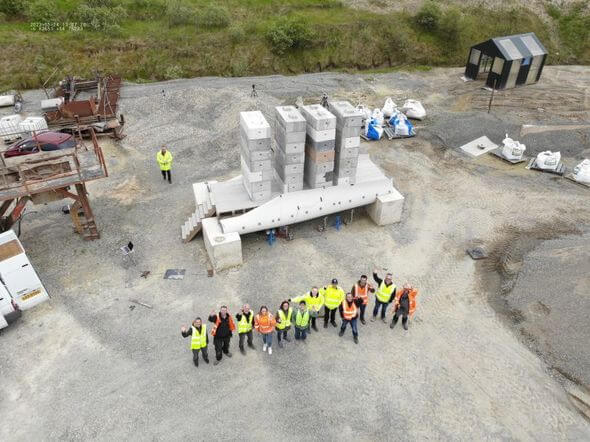Researchers transform landfilled wind turbine blades into footbridges
Over the last 30 years wind farm development has been scaled up globally but this is now posing a major environmental challenge. The turbine blades, which are non-biodegradable, have a lifespan of just 20-25 years. After this, they are either landfilled or incinerated.
Currently, there are around 11,000 wind turbines in the UK. Estimates suggest that 450 blades will be decommissioned in Ireland by 2030. Researchers also predict that based on a 20-year lifespan, there will be around 8.6 million tonnes of blades being decommissioned worldwide by 2042.
In a bid to tackle the challenge, a transatlantic research network ‘Re-Wind’ was set up to find new ways to repurpose the blades. Working together, geography experts, design architects and engineers have discovered that by using just two turbine blades they can create a bridge.
The network partners are Queen’s University Belfast, University College Cork, Georgia Institute of Technology, City University New York and Munster Technological University, Cork.
Already, the team have successfully built two footbridges in Ireland – a 7m span bridge in Draperstown, Northern Ireland, and a 5m span bridge in Cork in the Republic of Ireland. The bridges, which are made from two wind turbine blades, are known as ‘BladeBridges’ and passed rigorous testing in May. A third bridge is also underway in Georgia, Atlanta.
The researchers have also been looking at ways to use the blades to build bus shelters, barriers, street furniture and telecommunications towers.
Professor Jennifer McKinley is based in Geography in the School of Natural and Built Environment. She is lead for the project at Queen’s University Belfast and says: “I am delighted that by working together we’ve been able to find a way to repurpose wind turbine blades. This can only be a good thing as without intervention they would end up in landfill or they would have to be incinerated.
“With so many of these blades due to reach the end of their lifespan, we need to find ways to transform them into something useful.”
Professor Marois Soutos from Queen’s University comments: “It has been incredibly exciting and rewarding to work on this project. As researchers, we like to push things as far as we possibly can in order to come up with the best solution available. In this instance, we’ve been able to create a footbridge from two wind turbine blades which is able to hold 30 tonnes – that’s the weight of a digger.
“This could have a very positive impact for society going forward as we are only going to have more of these blades becoming decommissioned as the years go on.”
For the Draperstown bridge, CAD modelling was used and bolts were added to the blades but the researchers had concerns that these might tear when weight was added. It was tested by loading it with 34 blocks, each weighing 1,100kg and the results were very positive – the bridge was able to take much more weight than expected.
Kenny McDonald, Technical Manager in the School of Natural and Built Environment at Queen’s University, said: “We designed the bridge to avoid failures and during testing there was no tearing, no failure at all. We kept loading these concrete blocks and we could not get the bridge to fail.
“Tackling problems and coming up with solutions is our bread and butter as researchers and it takes a lot of imagination but that’s what makes it exciting. We did all of the testing for the bridge in Queen’s and we then travelled over an hour away to the site at Creagh Concrete to build the bridge. They’ve been a great help in supporting us with the build and the testing and we are delighted that the bridge is functional and strong.
“We’re continuing to work with the Network and our colleagues in the USA on the bridge in Atlanta. After this, we would like to see if more blades can be added to make it longer. We’d like to join two together and increase the length. We’re hoping to secure further funding to do this.”
Three of the researchers from University College Cork and Munster Technological University have now created a spin-out from the Re-Wind research, called BladeBridge. They’ve been looking at a variety of uses for the blades.
BladeBridge co-founder Dr Angie Nagle comments: “We are partnering with well-known designers here in Ireland to create a portfolio of durable and sustainable products, such as greenway furniture and bridges. Our first customer was Mayo County Council, who recently installed a suite of our furniture on the greenway extension in Achill.”
The bridge in Cork was completed in January 2022 and funded under the Irish Department of Transport’s Project Ireland 2040 initiative. The second bridge was funded by Science Foundation Ireland, the Northern Ireland Department of the Economy, and the US National Science Foundation, via the US-Ireland R&D Partnership.
- Source:
- Queen's University Belfast
- Author:
- Press Office
- Link:
- www.qub.ac.uk/...
- Keywords:
- Queens University Belfast, landfill, wind turbine, rotor blade, briidge, research, footbridge, digger, lifespan, Northern Ireland, UK









